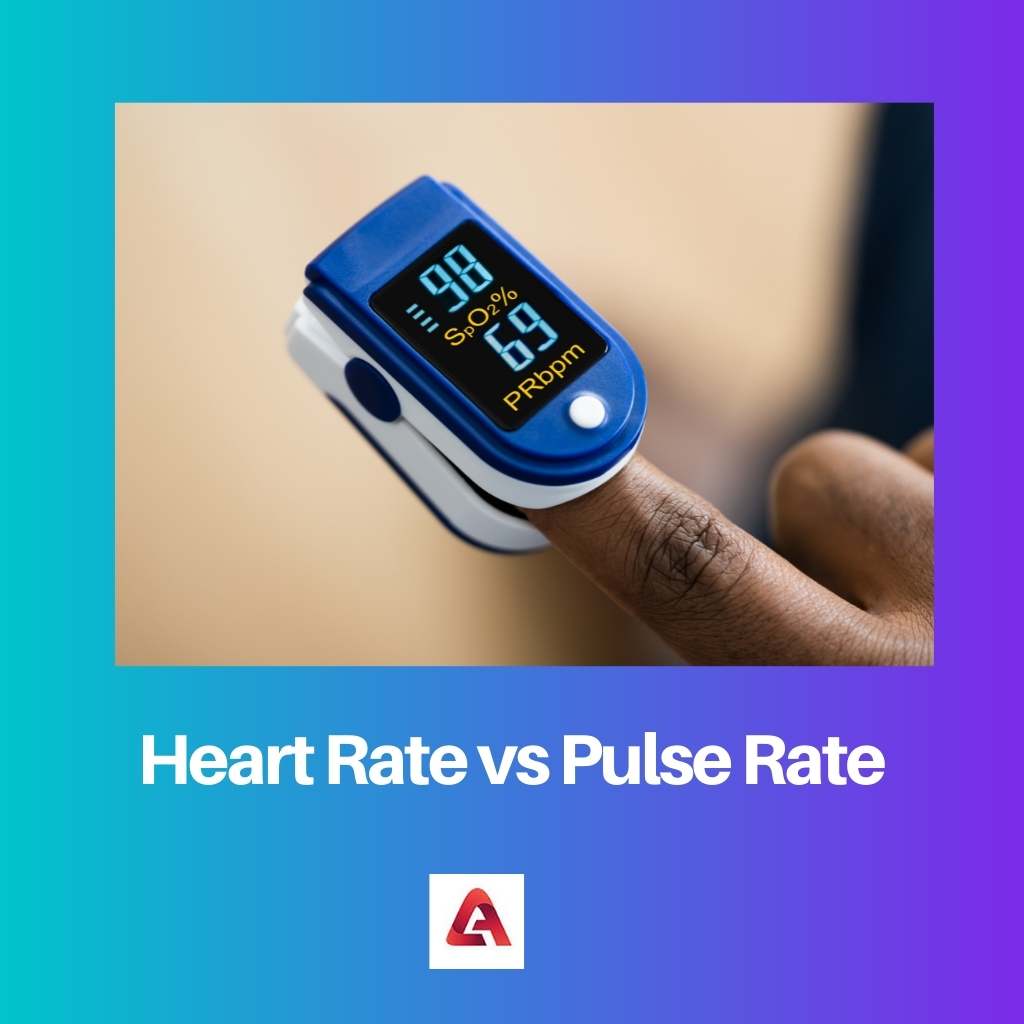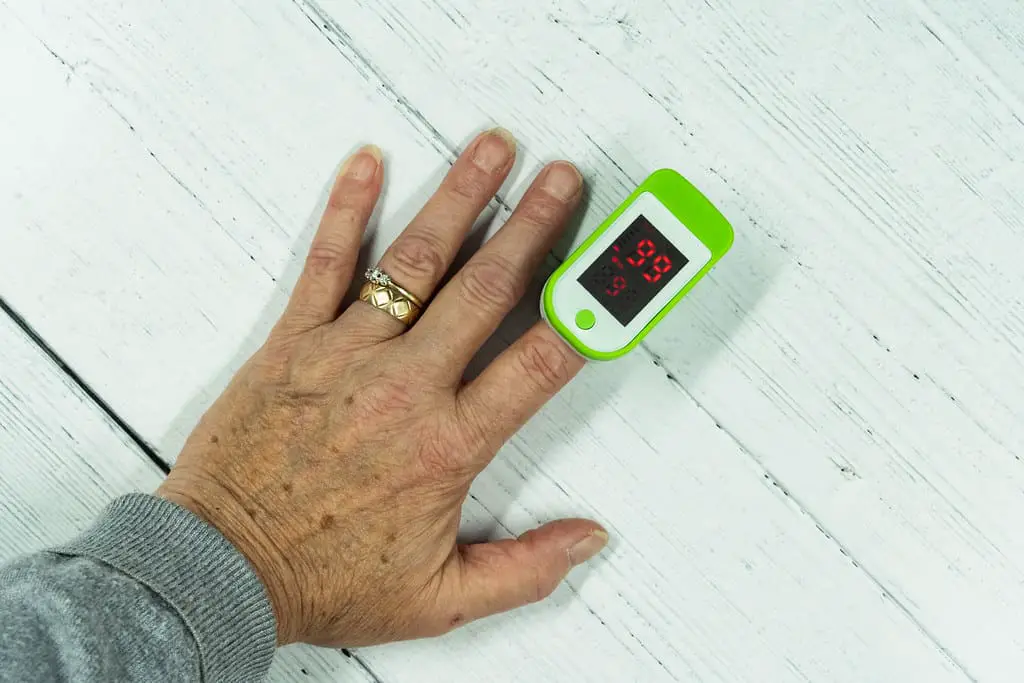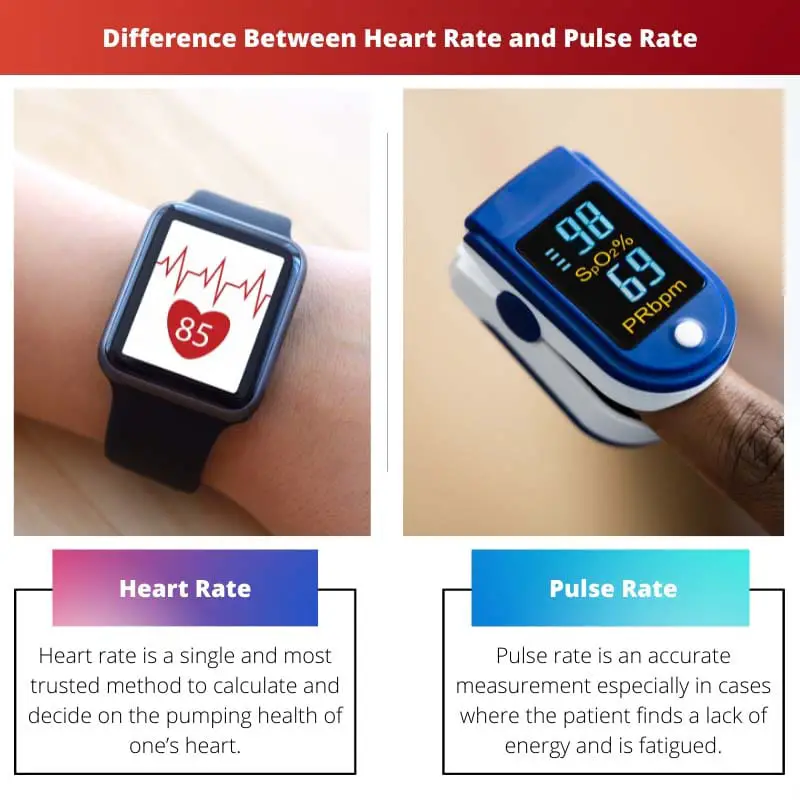Heart rate and pulse rate, in much sense, provide the patient with the same information.
The general outline of both points the doctor on a diagnostic spree that is in the same direction, and all are related to the heartbeat and blood pressure rate that occurs in a span of an internationally accepted time limit that is a minute.
Key Takeaways
- Heart rate measures the number of times the heart beats per minute, while pulse rate counts the number of arterial pulsations per minute.
- Heart and pulse rates are essential indicators of cardiovascular health but may not always be equal.
- Pulse rate can be measured manually or with a pulse oximeter, whereas heart rate requires an ECG or monitor.
Heart Rate vs Pulse Rate
The difference between heart rate and pulse rate is that while heart rate gives the contractile activity of the heart, thereby figuring out the heartbeat given in a minute, pulse rate provides a wider look into the blood pressure variations and the capability of the arteries and veins in their pumping activity. The movement of the blood pumped by the heart into the arteries is measured with the help of the pulse rate.

Heart rate is the single and most trusted method to calculate and decide on the pumping health of one’s heart. Being a muscular organ formed from the muscle type cardiac that is found only in the heart, the heart rate is an excellent figurative calculation regarding the functional condition of the pumping unit.
In modern medical terms, heart rate is the direct calculation of the number of times the heart beats given in a minute.
Pulse rate is an accurate measurement, especially in cases where the patient finds a lack of energy and is fatigued. It helps in identifying the efficiency of the blood pressure gradient system within the body.
Figurative decoding of the heartbeat can also be said to define the pulse rate that can be measured through multiple methods from multiple measurement points.
Comparison Table
| Parameters of Comparison | Heart Rate | Pulse Rate |
|---|---|---|
| The Variation due to Sudden Motion | Barely visible | Great changes seen |
| Variations Caused by Medicine | Highly fatal | Not severe |
| Points of Measurements | Measured over the chest | Multiple points like the side of neck and wrists |
| The Effect on Cardiac Muscles | Proves the efficiency of the muscles | Doesn’t show any effect on the muscles |
| Measures | Number of heartbeats per minute | The blood pressure gradients |
What is Heart Rate?
When a patient comes in with pale skin or any bluish hue to their body, the first thing a physician measure is their heart rate.
This is because the pumping of the heart indirectly measures the blood that reaches the tissues, giving the patient the energy required by the body.
This energy is supplied by the oxygen in the blood that is oxygenated in the lungs and then pumped by the heart via the systemic circulatory system. The contraction of the cardiac muscles taken within 100 seconds can also be used as a definition for heart rate.
The regular heart rate of a normal adult at rest or in no exertion mode is between 60 and 100. This means that the person’s cardiac muscles beat and therefore pump blood into the aorta 60-100 times per minute.
The heart rate can also indicate the swiftness of the cardiac muscles. This means that it can indicate how fast the muscles beat.
A heart rate below the minimum value of 60 or even lower comparatively doesn’t always mean that a person is in danger of cardiac arrest and death. It can also be an indication of perfect health and smooth functioning muscle cardiac muscles.
This is conclusive proof that the heart need not beat overly fast and aggressively to have the body supplied with the required amount of oxygenated blood.
But if the heart rate is too low constantly, it might indicate that the patient requires immediate medical care. There could be several reasons as to why the heart rate is low. One of them is the medications consumed by the patient.
If not prescribed by a registered doctor, it is better to consult one before consuming the medicines, as they can have side effects on the patient’s body.
These side effects include a highly reduced or extremely high heart rate, glucagon production in the body, increased blood glucose level and thickening of the blood.
Other reasons for low heart rate are irregular heartbeats, angina pectoris, or even high blood pressure. This is because their body needs at least twice the amount of oxygen required by a normal adult to satisfy the needs of the tissue.

What is Pulse Rate?
Pulse rate, in many ways, relates to one’s blood pressure variations and gradual changes along the body. Pulse rate can be identified as the blood pressure indicator as each time it’s measured, and the ultimate BP level could be known within the body.
The sense receptacles in the heart give an ideal measured value that identifies heart murmurs that sometimes prove to be fatal when unidentified.
A greater advantage of being able to measure pulse rate to identify blood pressure and heartbeat is that it could be calculated from many points.
The measuring points are the wrists and sides of the neck. These are the commonly checked and most accessible points. Other spots are the elbow’s inside or the foot’s underside when stretched.
The regular pulse rate for a normal adult at rest is between 60-80 or even 100. This is calculated within a minute. This means the amount of blood that the heart releases in a minute could be measured by the heartbeat rate.
The contraction of the heart creates a pulse pressure within the blood vessels of the human body that leads to a rise in the blood pressure and, therefore, the pulse rate.
As the heart reduces the amount of oxygenated blood pumped out by the systemic circulatory system, the pulse rate will eventually go below the heartbeat per minute.
If the pulse rate keeps reducing or rising above the average value, it can’t always be considered a negative factor. It can be an indication of a healthy lifestyle with deep workouts and an athletic lifestyle.
The positive elements of the rapid variations in pulse rate are stress management capability and inclusively healthy eating habits and lifestyles. But it could also have a few negative impacts. Smoking and obesity give drastic dips and rises in pulse rates.

Main Differences Between Heart Rate and Pulse Rate
- While the pulse rate can be measured from many concentration points all over the body, the heart rate can only be calculated by placing a hand over the heart or by a stethoscope.
- The heart rate indirectly helps in the upward push of the blood to the brain primarily; on the other hand, the pulse rate is a systemic calculation of the blood pressure gradient along the body.
- In cases when the heart can’t pump enough blood, the pulse rate can drop below the heartbeat per minute, whereas the heart rate tends to stay the same.
- A frequent increase or decrease in pulse rate can indicate a negative and positive impact on the body system, whereas such frequent changes in the heart rate might create a pathway for heart disorders.
- While the heart rate is a direct measure of the heartbeat, the pulse rate is a measurement of the upsurge of the blood, that is, the blood pressure.

- https://onlinelibrary.wiley.com/doi/abs/10.1002/clc.4960130811
- https://www.sciencedirect.com/science/article/pii/000287039190970S

While this article is very thorough, it fails to mention the potential dangers of self-diagnosis and emphasizes the importance of consulting a medical professional for accurate assessment and advice.
Heart rate and pulse rate are two crucial indicators of cardiovascular health. This article provides a comprehensive comparison, but it doesn’t emphasize the importance of consulting a professional for individual health concerns.
The content is informative and helpful to understand the differences between heart rate and pulse rate. This knowledge is valuable for maintaining cardiovascular health.
The author provides an in-depth comparison between heart rate and pulse rate, highlighting their significance and relevancy to cardiovascular health. It’s refreshing to see such valuable health information shared.
I appreciate the detailed breakdown of how heart rate and pulse rate are measured, and their respective impacts on the body’s functionality.
This article does a great job at explaining the differences between heart rate and pulse rate. The author does a fantastic job at providing in-depth information.